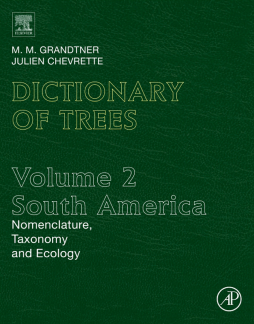
Additional Information
Book Details
Abstract
Dictionary of South American Trees provides a single-source reference for botanists, biologists, ecologists, and climatologists on the many native trees in South America. The index lets readers find a tree in four languages, by its common name, or abbreviation, followed by taxonomy that includes common uses for each part of the tree.
Using this information, scientists and students can identify and classify plants, their growth structure and environment, the uses of their products, and alternative options with similar characteristics.
- Complete coverage of all native South American trees—the only single-source reference for botanists, biologists, ecologists and climatologists working in this diverse and changing region
- Includes taxonomy at genera, species, sub-species, and varietal levels, providing information from the most basic level up and allowing readers to identify their subjects using numerous criteria
- Indicates Latin, English, French, and Spanish names as well as common names and abbreviations, facilitating accurate and efficient identification
- Provides growth information, climatology, ecology and uses for the tree to provide insight into each tree as well as for comparative purposes when seeking similar tree-based resources
"The dictionary contains in alphabetical order of scientific name all known species, subspecies and varieties of trees of the South American continent…family relationship and English, French and Spanish names are listed."--Archive of Forest Science,July-August 2014
"The second volume in the set, this dictionary focuses on native trees in South America, presented in alphabetical order by Latin name. It excludes fossil and more recently extinct taxa, hybrids, and cultivars. Each generic entry includes the family, synonyms of the Latin name, and English, French, Spanish, trade, and other names. Infrageneric entries also include the distribution, height, type of foliage, ecological characteristics, and main uses."--ProtoView.com,February 2014
